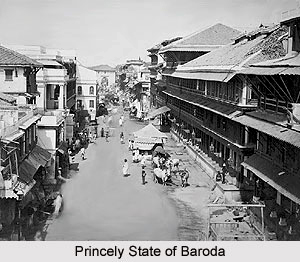 The Princely State of Baroda was ruled since its formation in the year 1721 by the Gaekwad dynasty till the year 1949, when the princely state was acceded to the Union of India. The city of Baroda, presently known as Vadodara, served as the capital of the state. During the British rule in India, the Baroda Residency managed its relations with the British administration. Baroda was amongst the wealthiest and largest princely states in India which existed alongside British dominated India and lucratively earned from the developing cotton industry as well as cultivation of wheat, rice and sugar. During the period when the nation attained independence, the Maharaja Gaekwad of Baroda was among the only five Indian princes, including the Maharaja Scindia of Gwalior, the Maharaja of Jammu and Kashmir state, the Maharaja of Mysore and the Nizam of Hyderabad, who were honoured with a 21 gun salute. On 1st May 1949, the princely state of Baroda was officially acceded to the Union of India, before which an interim government was established in the princely state.
The Princely State of Baroda was ruled since its formation in the year 1721 by the Gaekwad dynasty till the year 1949, when the princely state was acceded to the Union of India. The city of Baroda, presently known as Vadodara, served as the capital of the state. During the British rule in India, the Baroda Residency managed its relations with the British administration. Baroda was amongst the wealthiest and largest princely states in India which existed alongside British dominated India and lucratively earned from the developing cotton industry as well as cultivation of wheat, rice and sugar. During the period when the nation attained independence, the Maharaja Gaekwad of Baroda was among the only five Indian princes, including the Maharaja Scindia of Gwalior, the Maharaja of Jammu and Kashmir state, the Maharaja of Mysore and the Nizam of Hyderabad, who were honoured with a 21 gun salute. On 1st May 1949, the princely state of Baroda was officially acceded to the Union of India, before which an interim government was established in the princely state.
History of Princely State of Baroda
The state of Baroda was founded in the year 1721 after Pilaji Gaekwad, the Maratha general, occupied Songadh from the Mughals. The British East India Company took control of most of the territories in Gujarat after the Second Anglo Maratha War from 1803 to 1805. But the Gaekwads of Baroda managed to maintain good relations with the British administration and entered into a subsidiary alliance that accepted the suzerainty and control of the British over the external affairs of the state in return for retaining internal autonomy.
During the beginning of the 20th century, the associations of the 4 major princely states, Baroda, Jammu and Kashmir, Mysore and Hyderabad, with the British Government of India were administered by a British Resident which was under the direct control of the Governor General of India. According the 1911 census of India, the princely state of Baroda had a total population of 2,032,798 people and the state covered a total area of 8,182 sq km. Later in the year 1930, the Baroda Residency was united with the princely states that were nearby the northern part of the Bombay Presidency, which formed the Baroda, Western States and Gujarat Agency. On October 27, 1940, an improved State Legislative Assembly called Baroda State Praja Mandal was formed and Sardar Vallabhbhai Patel was appointed as the President. The Baroda State Railway was unified with the Bombay, Baroda and Central India Railway in the year 1949, after the nation became independent.
The princely state of Baroda, which was the 3rd largest princely state during the Brittish rule in India, was officially acceded to the Union of India on 1st May 1949. In the beginning, Baroda was combined with the Bombay state, but later on 1st May 1960, with the formation of the states of Maharashtra and Gujarat, Baroda was merged with Gujarat.
Rulers of Princely State of Baroda
The chronology of the rulers of the Princely State of Baroda is mention below-
* Pilaji Rao Gaekwad (1721- 1732)
* Damaji Rao Gaekwad (1732- 1768)
* Govind Rao Gaekwad (1768- 1771)
* Sayaji Rao Gaekwad I (1771- 1789)
* Manaji Rao Gaekwad (1789- 1793)
* Govind Rao Gaekwad (1793- 1800)
* Anand Rao Gaekwad (1800- 1818)
* Sayaji Rao II Gaekwad (1818- 1847)
* Ganpat Rao Gaekwad (1847- 1856)
* Khande Rao Gaekwad (1856- 1870)
* Malhar Rao Gaekwad (1870- 1875)
* Maharaja Sayaji Rao Gaekwad III (1875- 1939)
* Pratap Singh Gaekwad (1939- 1951)






































